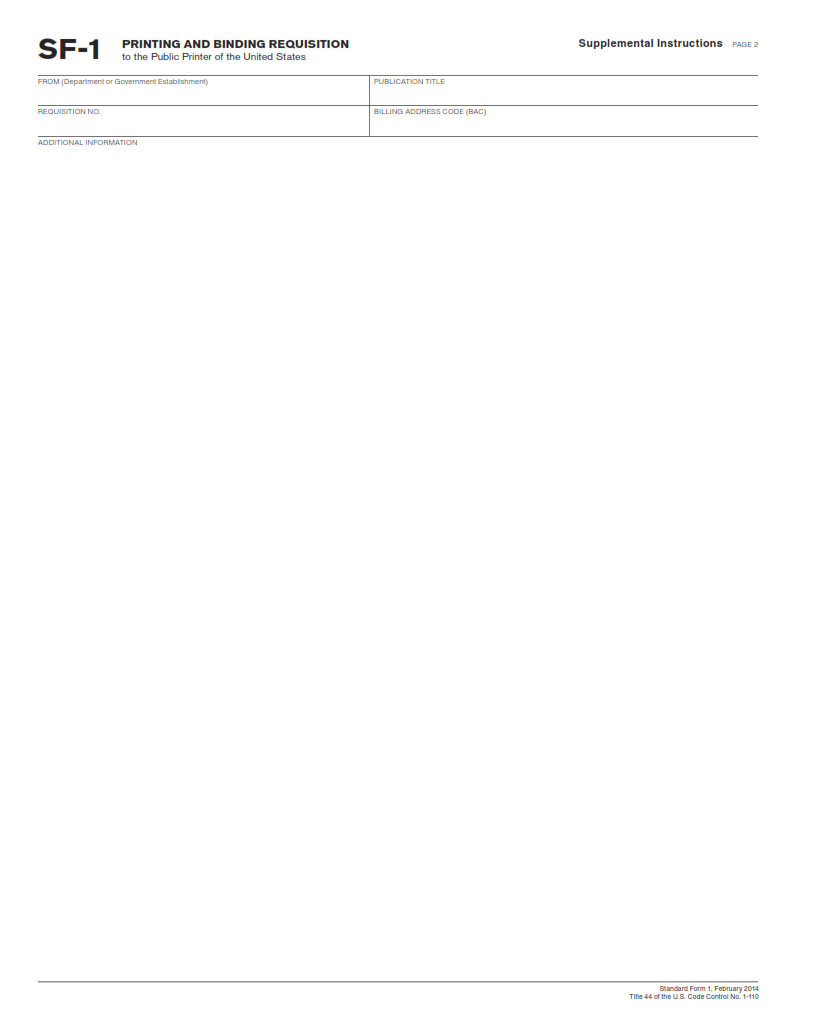SFFORMS.COM – SF 1 Form – Printing and Binding Requisition to the Public Printer of the United States – Since its inception in 1813, the United States Public Printer has been responsible for printing and binding government documents. Today, one of the many forms it offers is SF 1, a requisition form for services from the Public Printer. This article will provide an overview of SF 1 form requirements and instructions for filing. It will also discuss the various services available through the Public Printer and how to access them.
Download SF 1 Form – Printing and Binding Requisition to the Public Printer of the United States
| Form Number | SF 1 Form |
| Form Title | Printing and Binding Requisition to the Public Printer of the United States |
| File Size | 270 KB |
| Date | 02/2014 |
What is an SF 1 Form?
The SF 1 Form serves as a printing and binding requisition to the Public Printer of the United States. It is used by government agencies to request printing services from the Government Publishing Office (GPO). The GPO is responsible for producing and distributing information products and services for all three branches of the federal government.
The SF 1 Form contains important details about the printing job, such as quantity, paper type, ink color, and finishing options. Agencies must complete this form accurately to ensure that their print job is produced correctly. Once completed, agencies submit the form to the GPO through their agency’s authorized representative.
It’s worth noting that not all government agencies are required to use the SF 1 Form when requesting printing services from the GPO. Some agencies have authority to order directly through a program called “Quick Copy,” which handles small-scale copying jobs without going through a formal requisition process. However, for larger or more complex projects requiring professional printing services from GPO experts, completing an accurate SF 1 Form is crucial in ensuring that your project is a success.
What is the Purpose of the SF 1 Form?
The SF 1 Form, also known as the Printing and Binding Requisition to the Public Printer of the United States, serves an important purpose in government printing. This form is used by federal agencies to request printing services from the Government Publishing Office (GPO). The GPO is responsible for producing a wide range of printed materials for government agencies, including books, reports, forms, and signage.
The SF 1 Form includes all the necessary information needed to create a print job. This includes details such as the type of publication required, number of copies needed, paper size and weight specifications, binding requirements and any special instructions. The form must be filled out accurately to ensure that the final product meets all requirements.
Once completed and submitted by an authorized representative of a government agency or department to the GPO’s Office of Customer Services via email or fax machine; it will be processed according to standard procedures developed over many years within this organization so that high quality products are delivered on time with minimal errors or defects. Where Can I Find an SF 1 Form?
SF 1 Form – Printing and Binding Requisition to the Public Printer of the United States
The SF 1 Form is a requisition document used by government agencies to request printing and binding services from the Public Printer of the United States. This form is required for all federal agencies that need to print and distribute official publications, such as reports, manuals, and forms.
One important aspect of completing the SF 1 Form is providing accurate information about the publication being printed. This includes details such as size, number of pages, and quantity needed. Agencies must also specify any special requirements for printing or binding, such as color printing or spiral binding.
Once the SF 1 Form has been completed and submitted to the Public Printer’s office, it goes through a review process to ensure that all necessary information has been provided. The printing process can then begin, with careful attention paid to quality control measures throughout each stage of production. By utilizing this standardized form and working with the Public Printer’s office, federal agencies can efficiently produce high-quality publications that meet their specific needs.
SF 1 Form Example

